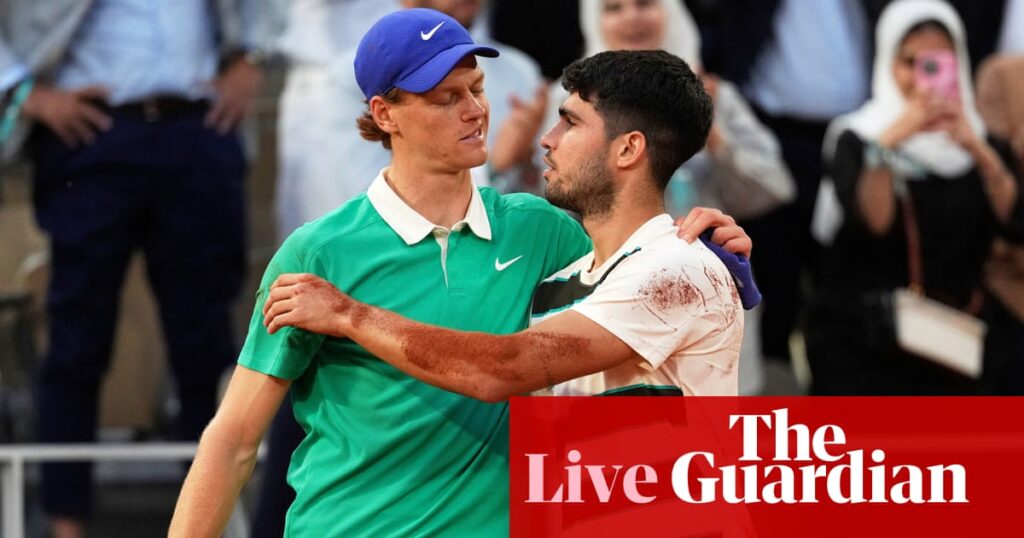Key events
Show key events only
Please turn on JavaScript to use this feature
On the same topic, here’s Calvin Betton, our resident coach. “Nothing at all to add really since Wimbledon. Same stuff. They’ll both blast away, whoever plays better will win. One of them will try a drop shot or a serve and volley and people will get excited that it’s a tactical move. It’s not.”
Share
Where is the match?On a hard court, if Sinner can get on top of the bounce, he’s hard to stop because his groundstrokes are so reliable and so true. He has, though, had trouble against players who unleash on the forehand – Dimitrov, Bublik – but are canny on the back, their slicing forcing him to dig out responses.
Sinner, meanwhile, will look to put Alcaraz under constant pressure, standing on the baseline while cramping him for room and time. If his second serve is firing, it’ll take something serious to deny him.
Share
Also going on:
Share
Preamble
Yes yes y’all, and welcome to the US Open 2025 – day 15!
It feels like we’ve been here before, doesn’t it? For the third grand slam in a row and for the first time ever in an open-era calendar year, the same players meet to decide which of them takes home the big pot, just as we knew they would. We invite sport into our lives because we don’t know what’s going to happen, except in men’s tennis we now know exactly what’s going to happen: Jannik Sinner and Carlos Alcaraz will beat whoever is put in front of them, handily. There is no sign whatsoever that this will stop being the case anytime in the next decade.
But though it might feel like we’ve been here before, verily we have not. Each time these two play, they grow, and each time they play each other they’re telling us a new story, a fresh mesh of styles and characters demanding we conceive of them and ourselves differently.
The pair are easy to characterise. Sinner is even, flowing, and predictable, doing things you can’t believe but can predict: he picks the right shot even if it’s the hardest shot, then executes with style and poise that is perfect. Alcaraz, on the other hand, is capricious, extravagant and visionary, doing things you can neither predict nor believe: technically he is impure but mentally he is unique, conjuring angles and trajectories geometry has yet to discover, perfect because of his imperfections.
In individual sport, players come and go, so to sustain us, we need them to stand for something, and we will, all of us, have a favourite in the fight: the one who is closer to expressing who we are or, if we’re honest with ourselves, who we’d like to be. The reality, though, is a little more nuanced. Unlike, say, Jimmy Connors and John McEnroe, these two aren’t sticking to their given identity partly to spite the other, nor are they, like, say, Stefan Edberg and Boris Becker, continuing to do what they do in the belief that if they do it well, it will be enough. Rather they are studying each other and, more particularly, studying themselves in the light of each other, rethinking and remodelling as they go. So Sinner is now fitter and more daring, while Alcaraz is less impetuous and error-prone; their rivalry is not a series but a serial, with character driving plot not the other way around.
There’ s a notion that Sinner’s Wimbledon win evidenced him moving clear – a hard court suits his organised power-game, just as the variable, lower bounce on grass and clay works better for Alcaraz, so if he’s winning on one of his less natural surfaces, he is likely to be impregnable on the one that seems made for him. On the other hand, Alcaraz has developed a new consistency which, when added to his artistic gifts and preternatural timing, means that if he plays close to his best, he’s close to unbeatable.
Which is to say though previously we knew what was going to happen, presently we’ve not a clue what’s going to happen. It’s time to settle in and find out.
Play: 2pm local, 7pm BST
Share
Discover more from 6up.net
Subscribe to get the latest posts sent to your email.


